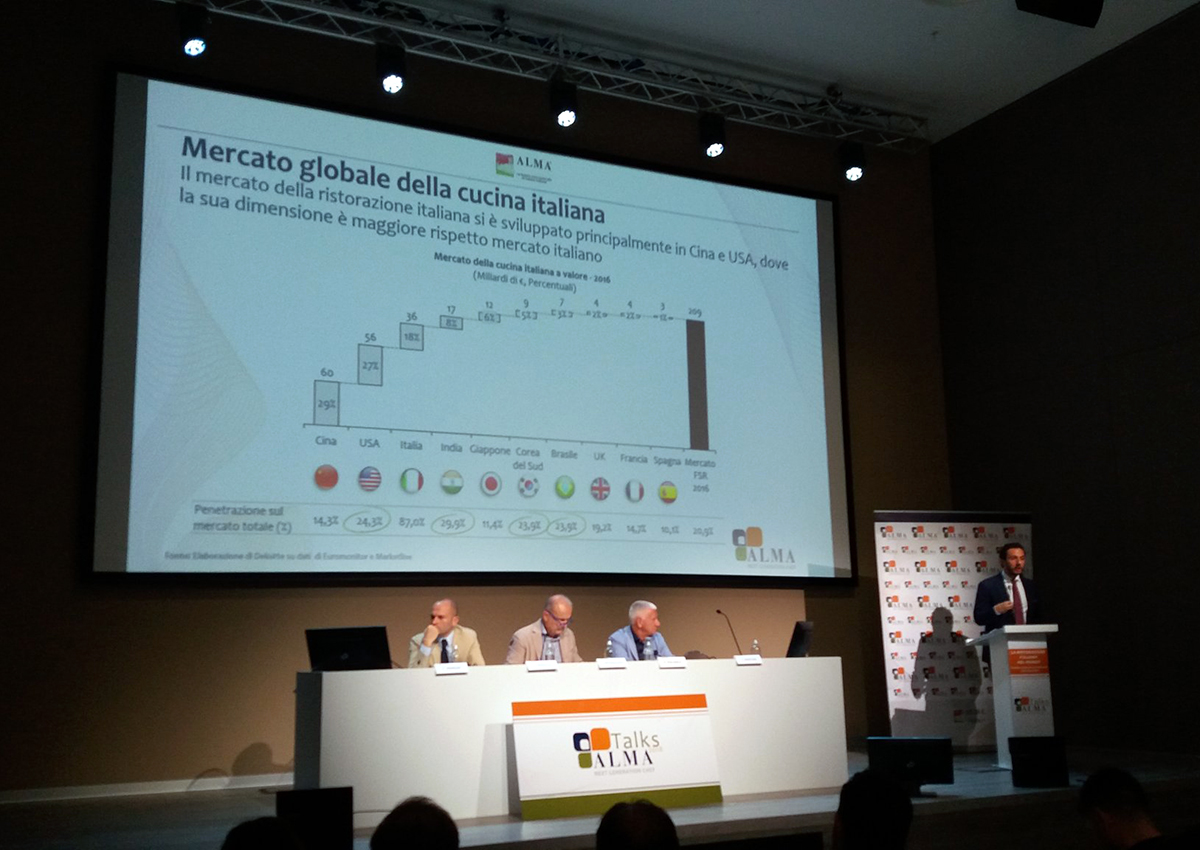
FICO Eataly World was the location where the fourth round of the ALMA Talks cycle took place – the meetings of the ALMA International School of Italian Cuisine aimed at training the ‘Next Generation Chef’. The theme of the last talk was ‘Italian catering in the world. Trends and business in the international market’.
The speakers
ALMA Talks take place under the patronage of the Italian Ministry of Foreign Affairs and Cooperation. Tiziana Primori, CEO of FICO, welcomed the guests who took turns on stage: Cristiano Musillo (Councillor at the General Direction for the Promotion of the Country System of the Ministry of Foreign Affairs and International Cooperation), Tommaso Nastasi (Business Advisory Coordinator of Deloitte Financial Advisory), and Enzo Malanca (President of ALMA).
The survey
In this context, the research on Italian cuisine and catering in the world commissioned by ALMA and developed by Deloitte was presented. This is what emerged, summarized in 10 points:
1 – The global catering market reached 210 billion euro in 2016, with the Asia-Pacific area covering 46% of the total and the Full-Service Restaurant channel (restaurants with more or less formal table service) weighing 52%.
2 – The fastest growing distribution channels are Street Food and Quick Service Restaurant (low/medium quality restaurants with no table service), respectively +6.1% and +5.3% in the compound annual growth rate 2011-2016 (from now on abbreviated as CAGR). The Full-Service Restaurant channel is the most important channel and grew by + 4.9% CAGR 11-16.
3 – In terms of geographical areas, Asia-Pacific and North America are driving growth (+5.6% and +4.0% CAGR 2011-16 respectively), while Europe is stable (+0.4% CAGR 2011-16).
4 – Among the driving factors behind the growth of the market in Asia-Pacific we can find the increase in consumption away from home; frequent consumers (more than three meals away from home per week) have gone from 27% to 30% (2012-16).
5 – Market growth is expected in the coming years (+3.1% CAGR 2016-21), driven mainly by North American performance (+4.1% CAGR 2016-21). Europe is growing once again at a faster pace compared to its historic past, also thanks to a more positive macroeconomic scenario (+ 3.3% CAGR 16-21).
6 – Within the Full-Service Restaurant channel, the top 10 countries in terms of size represent almost 90% of the global market; Asia-Pacific is the main market in terms of value and growth (+6.7% CAGR 2011-16); North America shows a better trend than Europe (+3.6% vs +0.3% CAGR 2011-16); Italy is the fifth country with a share of 4% (42 billion euro in turnover generated).
7 – Italian cuisine is the second globally after Chinese (13% market share), showing a higher penetration in terms of number of transactions in the U.S. (15%), UK (15%), Brazil (13%), and India (13%).
8 – According to experts in the sector, Italian cuisine is expected to grow strongly favoured by the perceived quality of raw materials and the positive effect and diffusion in TV shows.
9 – Worldwide, the turnover generated by Italian cuisine is estimated at 209 billion euros, of which 60 billion in China and 56 billion in the United States.
10 – Employment in the catering sector tends to grow particularly in the main emerging countries, with the roles of chef and cook representing the main jobs for Culinary Art Education graduates (54% and 23% respectively).
Global profile
Presenting the results of the research, Tommaso Nastasi said: Italian cuisine in the world is the second at global level after Chinese cuisine with a 13% market share in terms of number of transactions and a generated turnover of 209 billion euros. The main challenge for Italian restaurants is to adapt to the new trends of consumption away from home, that are oriented towards a less codified cuisine, without losing the distinctive features of Made in Italy. The survey carried out by Deloitte is not merely an investigative tool. As Enzo Malanca said: We thought it appropriate to carry out an in-depth analysis of the vast and growing world of Italian catering, directing it towards an international perspective with which ALMA is increasingly confronted. With the Next Generation Chef meetings, the mission of the School is to respond to the need to train cooks and professionals through updated and modern teaching, based on the Italian tradition of hospitality.
A heritage to be protected
Cristiano Musillo, institutionally committed to promoting Italy throughout the world, added: High-quality Italian cuisine and all related catering activities represent a great cultural and economic heritage of our country; an asset that the Italian Ministry of Foreign Affairs is committed to protecting and making known through its diplomatic-consular network and the Italian Cultural Institutes abroad.
